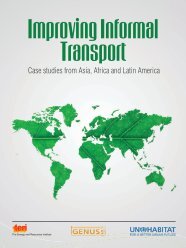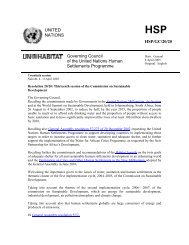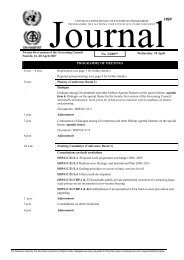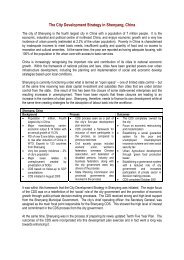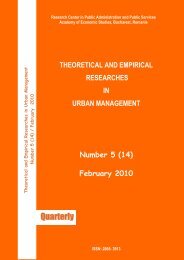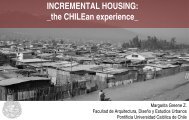Harmonious cities - UN-Habitat
Harmonious cities - UN-Habitat
Harmonious cities - UN-Habitat
Create successful ePaper yourself
Turn your PDF publications into a flip-book with our unique Google optimized e-Paper software.
OPINION Urbanisation — the engine of growth<br />
dropped dramatically from 37 percent in the<br />
mid-1970s to five percent in 2001. Urbanisation<br />
became the basic pillar of China’s economic<br />
growth and by 2020, we expect that<br />
60 percent of Chinese people will be living in<br />
urban areas.<br />
Amazingly, China has been able to absorb<br />
more than 370 million people into its <strong>cities</strong><br />
without the proliferation of urban slums.<br />
How has it done this? The experts who work<br />
on this at the Bank tell me there are a number<br />
of factors behind this achievement. But key<br />
among them are good national policies that<br />
give Chinese municipalities the authority to<br />
introduce and implement regulations governing<br />
land use, the transport system and the<br />
urban environment. Strong decentralised urban<br />
planning and utility management at the<br />
city level have also played a strong part in the<br />
success.<br />
China also recognised early on that urban<br />
development is not possible on the cheap and<br />
that building ahead of demand makes a lot<br />
of sense. For example, through the 1980s,<br />
Shanghai spent five to eight percent of its<br />
GDP on urban infrastructure to redevelop<br />
the city. Beijing and Tianjin now spend more<br />
than 10 percent of their GDP on roads, water<br />
and sewerage services, housing construction<br />
and transport. China’s phenomenal ability to<br />
mobilise financial resources for urban development<br />
through domestic credit and foreign<br />
direct investment is what keeps the funds for<br />
<strong>cities</strong> coming. Add all of this together and<br />
you start to see why China’s <strong>cities</strong> have coped<br />
more effectively with rapid urbanisation than<br />
<strong>cities</strong> in other middle and lower-middle-income<br />
countries.<br />
We have seen a similar story here in Singapore.<br />
At independence in 1965, 70 percent<br />
of Singapore’s householders lived in<br />
overcrowded conditions and a third of the<br />
population squatted on the city’s fringes. Unemployment<br />
rates averaged 14 percent and<br />
half the people were illiterate. Just over 40<br />
years later, the slums are gone and the city<br />
has grown into one of the most productive,<br />
creative and functional in Asia. Again, the<br />
secret lies in a combination of innovative<br />
and forward-looking policies, investments<br />
in education and infrastructure, and a concerted<br />
bid to attract foreign capital and talent.<br />
It’s another example of Asia’s forward<br />
looking attitude to urbanisation. Embracing<br />
it rather than fearing it. And taking it a step<br />
8<br />
u r b a n<br />
WORLD<br />
November 2008<br />
further, Singapore wants to share what it has<br />
learned with others. The World Bank and the<br />
Government of Singapore are currently discussing<br />
setting up a regional hub for training<br />
urban practitioners – this would draw on and<br />
share Singapore’s phenomenal knowledge<br />
and experience.<br />
This link between well planned, successful<br />
<strong>cities</strong> and prosperity is not limited to Asia.<br />
More and more we are also seeing middle income<br />
countries like Brazil and Mexico turning<br />
<strong>cities</strong> into growth-inducing hubs that attract<br />
human capital and innovation.<br />
It’s this new thinking about <strong>cities</strong> and urbanisation<br />
that is a key focus of the World<br />
Bank’s forthcoming World Development Report,<br />
which also provides some calming findings<br />
for a debate that is sometimes prone to<br />
hysteria.<br />
• For example: It finds that the likely<br />
growth of <strong>cities</strong> has often been exaggerated.<br />
The populations of Shanghai,<br />
Sao Paulo and London in the year 2000<br />
were about two thirds of what had been<br />
predicted in 1974.<br />
• It shows that the current pace of urbanisation<br />
in developing countries, other<br />
than China, is not unprecedented, mirroring<br />
quite closely the experience of today’s<br />
high income countries at a similar<br />
stage of development.<br />
• It also finds that the growth rate of urban<br />
populations in developing countries is<br />
actually on the decline, having reached<br />
its peak in the 1970s although that’s not<br />
to dismiss the increasing challenge that<br />
current rates of growth bring.<br />
The report uses empirical evidence to show<br />
that spatial inequality within <strong>cities</strong> and between<br />
regions may increase in the early phases<br />
of development but declines with strong<br />
economic growth. England is a good example.<br />
In the 1830s, earnings in rural England were<br />
25 percent lower than those in <strong>cities</strong>. Today,<br />
average real disposable income is roughly<br />
equal in <strong>cities</strong>, towns and villages.<br />
When we look at the difference between<br />
lagging and leading regions, we see a similar<br />
pattern. Cambodia and Bangladesh (with<br />
GDP per capita of less than USD 300) have<br />
gaps in consumption between their leading<br />
and lagging areas of 89 percent and 73 percent<br />
respectively. But in Colombia and Thailand<br />
(with GDP per capita of approximately<br />
USD 2,000), the equivalent gaps are about 50<br />
percent. For Canada (with a per capita GDP of<br />
USD 20,000), the gap is less than 25 percent.<br />
In effect, <strong>cities</strong> draw people and firms to<br />
areas of higher productivity. Urbanisation<br />
is closely related to the way nations have<br />
shifted from agrarian to industrial economies<br />
and later to post-industrial economies.<br />
One of the messages of the World<br />
Development Report is that policy makers<br />
must recognise the spatial transformations<br />
that lie behind these sectoral shifts to enable<br />
places to prosper and specialise. No<br />
country has grown to high income without<br />
vibrant <strong>cities</strong>. But to be inclusive and efficient,<br />
policy makers must see themselves as<br />
managers of a portfolio of <strong>cities</strong> that are specialising<br />
and performing different functions<br />
according to their size and economic structure.<br />
Climate change<br />
Our strategy will also take into account<br />
the impact <strong>cities</strong> are having on the environment<br />
given the demand they place on<br />
countries to provide more energy, water, infrastructure<br />
and urban services generally.<br />
Climate change is a central consideration<br />
for governments and planners with <strong>cities</strong><br />
generating an estimated 70 percent of carbon<br />
emissions and with many urban centres<br />
located in vulnerable coastal regions. But<br />
climate change concerns should encourage<br />
us to rethink the shape of our <strong>cities</strong>, not<br />
mislead us into trying to slow down the pace<br />
of urbanisation.<br />
Urban energy<br />
Cities and their leaders are now armed<br />
with the knowledge and the desire of their<br />
constituents to strive for cleaner sources<br />
of energy, more effective urban transport<br />
systems that reduce dependence on private<br />
cars and more energy efficient buildings. As<br />
we’ve heard throughout this Summit, <strong>cities</strong><br />
all over the world are starting to push harder<br />
for green building standards and higher<br />
density development rather than encouraging<br />
more urban sprawl. At the same time as<br />
higher energy prices are helping to increase<br />
the density of <strong>cities</strong>, innovative mayors with<br />
foresight are also pushing this agenda with<br />
uncommon vigor as we have seen through associations<br />
of mayors in the United States, the<br />
UK and many other countries. u




